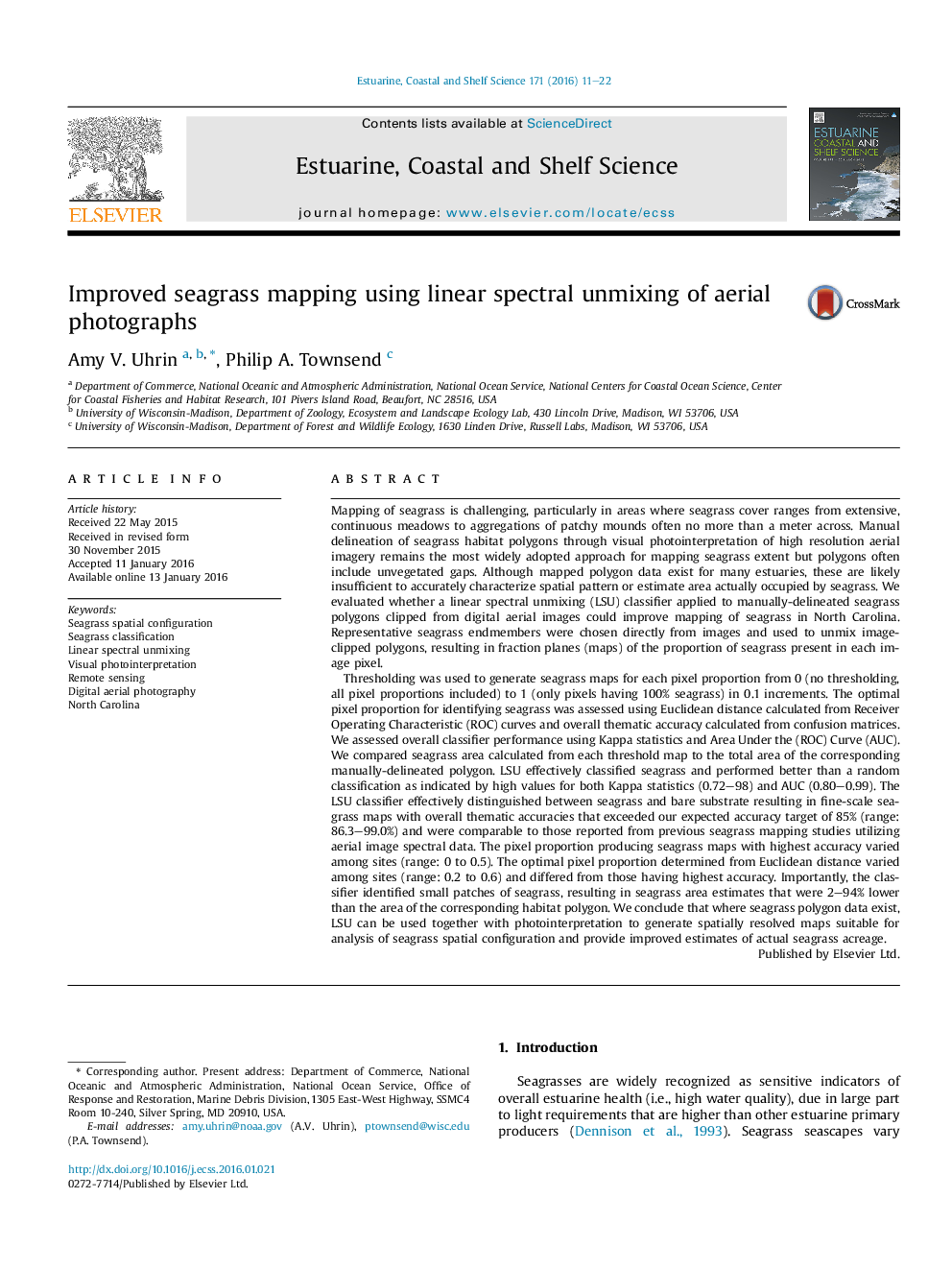| کد مقاله | کد نشریه | سال انتشار | مقاله انگلیسی | نسخه تمام متن |
|---|---|---|---|---|
| 4539277 | 1626628 | 2016 | 12 صفحه PDF | دانلود رایگان |
• Visually-interpreted maps preclude seagrass area estimation and pattern analysis.
• A semi-automated technique for seagrass classification is proposed.
• The technique relies on both visual interpretation and linear spectral unmixing.
• The technique identifies small seagrass patches while masking bare substrate.
• Seagrass acreage estimates and spatially resolved maps of pattern are generated.
Mapping of seagrass is challenging, particularly in areas where seagrass cover ranges from extensive, continuous meadows to aggregations of patchy mounds often no more than a meter across. Manual delineation of seagrass habitat polygons through visual photointerpretation of high resolution aerial imagery remains the most widely adopted approach for mapping seagrass extent but polygons often include unvegetated gaps. Although mapped polygon data exist for many estuaries, these are likely insufficient to accurately characterize spatial pattern or estimate area actually occupied by seagrass. We evaluated whether a linear spectral unmixing (LSU) classifier applied to manually-delineated seagrass polygons clipped from digital aerial images could improve mapping of seagrass in North Carolina. Representative seagrass endmembers were chosen directly from images and used to unmix image-clipped polygons, resulting in fraction planes (maps) of the proportion of seagrass present in each image pixel.Thresholding was used to generate seagrass maps for each pixel proportion from 0 (no thresholding, all pixel proportions included) to 1 (only pixels having 100% seagrass) in 0.1 increments. The optimal pixel proportion for identifying seagrass was assessed using Euclidean distance calculated from Receiver Operating Characteristic (ROC) curves and overall thematic accuracy calculated from confusion matrices. We assessed overall classifier performance using Kappa statistics and Area Under the (ROC) Curve (AUC). We compared seagrass area calculated from each threshold map to the total area of the corresponding manually-delineated polygon. LSU effectively classified seagrass and performed better than a random classification as indicated by high values for both Kappa statistics (0.72–98) and AUC (0.80–0.99). The LSU classifier effectively distinguished between seagrass and bare substrate resulting in fine-scale seagrass maps with overall thematic accuracies that exceeded our expected accuracy target of 85% (range: 86.3–99.0%) and were comparable to those reported from previous seagrass mapping studies utilizing aerial image spectral data. The pixel proportion producing seagrass maps with highest accuracy varied among sites (range: 0 to 0.5). The optimal pixel proportion determined from Euclidean distance varied among sites (range: 0.2 to 0.6) and differed from those having highest accuracy. Importantly, the classifier identified small patches of seagrass, resulting in seagrass area estimates that were 2–94% lower than the area of the corresponding habitat polygon. We conclude that where seagrass polygon data exist, LSU can be used together with photointerpretation to generate spatially resolved maps suitable for analysis of seagrass spatial configuration and provide improved estimates of actual seagrass acreage.
Journal: Estuarine, Coastal and Shelf Science - Volume 171, 20 March 2016, Pages 11–22
